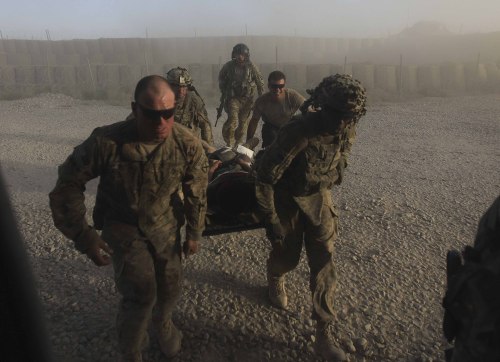Fierce fighting serves as reminder that war is not over in some parts
SIRAQULA, Afghanistan (AP) ― Shortly after the call to prayer resounded over the harvested poppy fields near Salaam Bazaar, two Taliban commanders were heard on their radios asking how their forces were doing.
The number of Taliban fighters who respond varies, but in the last month a squad of U.S. Marines at a small patrol base here in northern Helmand province counted 80 to 100 different radio call signs. The fighters usually thank God for their fortunes, report their casualties and track movements by the Marines.
SIRAQULA, Afghanistan (AP) ― Shortly after the call to prayer resounded over the harvested poppy fields near Salaam Bazaar, two Taliban commanders were heard on their radios asking how their forces were doing.
The number of Taliban fighters who respond varies, but in the last month a squad of U.S. Marines at a small patrol base here in northern Helmand province counted 80 to 100 different radio call signs. The fighters usually thank God for their fortunes, report their casualties and track movements by the Marines.

Then, using secret numerical codes, the commanders deploy fighters to the mud-walled farming compounds surrounding the Marines’ base.
Radio chatter picks up whenever Marines go on their daily patrols. On one recent day, the sound of men speaking in Pashto crackled over the Marines’ scanner five minutes after the troops left the base to conduct a patrol.
“We see the Americans,” a Taliban spotter said. “They have 15 people.”
In fact, six Marines, eight Afghan soldiers and two Associated Press reporters were on the dusk patrol.
As Helmand’s provincial capital of Lashkar Gah marked the official start of its transition from NATO to Afghan control on Wednesday, the fierce fighting in the market town of Siraqula served as a reminder that the war is still on in what remains the country’s deadliest province for coalition forces.
Lashkar Gah is one of five provincial capitals and two provinces that President Hamid Karzai deemed ready for Afghan control in the next several months.
The transition to Afghan control will allow international military forces to slowly start withdrawing from Afghanistan. NATO intends these transition areas to be the leading edge of an emergent sovereign state capable of quelling the insurgency and providing for its citizens by the time the coalition completes the withdrawal of combat troops in 2014.
It remains unclear, however, whether the modest security gains achieved in the provincial capital will expand to Taliban strongholds in northern Helmand, where U.S. Marines are still trying to pacify prime poppy growing areas that are the insurgency’s profit center.
The Marine patrol base in Salaam Bazaar is in a blocking position at the junction of three roads connecting the northern district centers of Nawzad to the northwest and Musa Qala to the northeast and Gereshk to the south.
Although Marines improved security in many of Helmand’s main population centers last year, motorcycle-borne Taliban still control roads with checkpoints and mines. The result has been a scattered archipelago of Helmand towns that are cut off from one another, a hobbled economy and provincial government institutions that cannot extend essential services.
With its 100 stalls, Salaam Bazaar was once a regional commercial center for farmers and small businesses until opium and arms dealers took it over and insurgents used it as a base to disrupt traffic on the Gereshk road. In May, Marines set up a patrol base less than a mile from the bazaar and tried to clear it for the second time in a year, but somehow the insurgency learned of the plan.
During the next several days, surveillance cameras mounted on an 80-foot tower at the patrol base monitored Taliban fighters planting a belt of mines around the bazaar.
Marines are building a new 10-stall bazaar along the main road to give traders an alternative to the Taliban-controlled marketplace and are trying to contain the insurgents so that roads to the north and south stay open. But the Taliban still use the old bazaar as a base.







![[Graphic News] More Koreans say they plan long-distance trips this year](http://res.heraldm.com/phpwas/restmb_idxmake.php?idx=644&simg=/content/image/2024/04/17/20240417050828_0.gif&u=)
![[KH Explains] Hyundai's full hybrid edge to pay off amid slow transition to pure EVs](http://res.heraldm.com/phpwas/restmb_idxmake.php?idx=644&simg=/content/image/2024/04/18/20240418050645_0.jpg&u=20240419100350)





![[From the Scene] Monks, Buddhists hail return of remains of Buddhas](http://res.heraldm.com/phpwas/restmb_idxmake.php?idx=652&simg=/content/image/2024/04/19/20240419050617_0.jpg&u=20240419175937)

![[KH Explains] Hyundai's full hybrid edge to pay off amid slow transition to pure EVs](http://res.heraldm.com/phpwas/restmb_idxmake.php?idx=652&simg=/content/image/2024/04/18/20240418050645_0.jpg&u=20240419100350)

![[Today’s K-pop] Illit drops debut single remix](http://res.heraldm.com/phpwas/restmb_idxmake.php?idx=642&simg=/content/image/2024/04/19/20240419050612_0.jpg&u=)